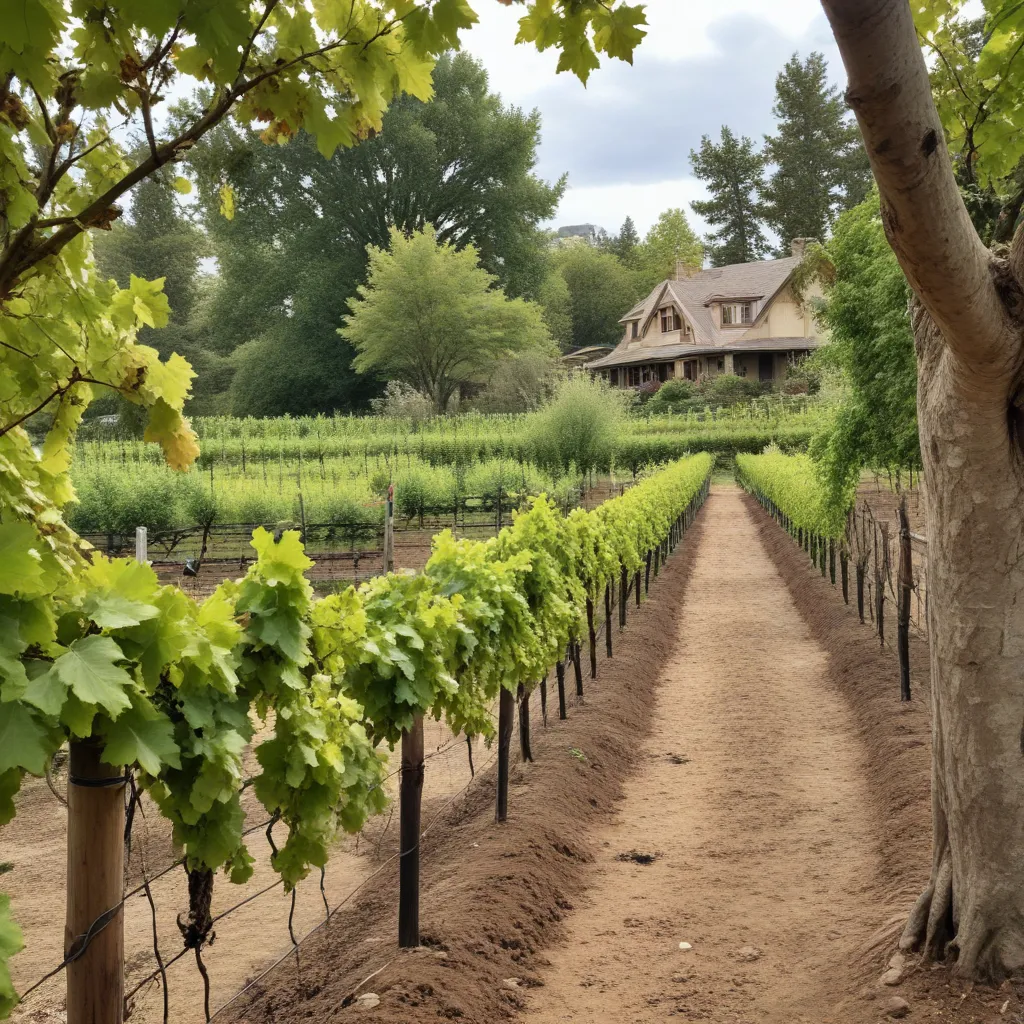
In the heart of the Garden State, the Wine Garden Inn has long been a beacon for wine enthusiasts seeking to explore the nuances of New Jersey’s terroir. Beyond its picturesque grounds and serene ambiance, this family-owned estate winery has carved out a reputation for crafting exceptional Italian varietals that thrive in the region’s diverse microclimates.
Unique Varietals
The story of Wine Garden Inn’s journey into Italian grape varieties can be traced back to the owners’ own heritage and passion for Old World winemaking. “In Italy, wine is part of the meal,” shares vintner Luca Turdo, whose Sicilian roots have deeply influenced the winery’s philosophy. “It’s just as important as the bread or plate of cheeses.” This mindset has translatedinto a focus on producing “food-friendly” wines meant to be savored alongside a meal.
Luca’s personal connection to his Italian background is evident in the winery’s selection of grapes. Nero d’Avola, an indigenous Sicilian red varietal, thrives in the sandy soils and extended growing season of the Cape May Peninsula American Viticultural Area (AVA), where the Wine Garden Inn is located. In recent years, the winery has also introduced Grillo, a Sicilian white grape, to their portfolio, further showcasing the versatility of Italian varietals in this unique terroir.
Meanwhile, over in the Central Delaware Valley AVA, vintners Violetta and Sergio Neri of Hopewell Valley Vineyards have also found success with Italian grape varieties. Though not of Italian descent themselves, the Neris’ deep appreciation for Italian culture and viticulture led them to plant Sangiovese and Barbera, two iconic Italian red grapes, in their vineyards. “The Neris knew the varietals would thrive in the Garden State’s terroir,” explains Luca, highlighting the adaptability of these grapes to New Jersey’s climate.
Terroir Influence
The key to the success of Italian varietals in New Jersey, according to Luca, lies in understanding the distinct terroir of each region. “The further south you go, the better for growing Italian varietals,” he notes, pointing to the extended growing season and warmer temperatures found in the Cape May Peninsula. The sandy soils of this region provide excellent drainage, while the proximity to the water helps moderate temperatures, allowing grapes to reach full physiological maturity.
In contrast, the Central Delaware Valley AVA, where Hopewell Valley Vineyards is located, presents a slightly more challenging environment for Italian varietals. Violetta Neri acknowledges that it may take “a stretch of one to two hundred years” before they can fully realize the potential of these grapes in their terroir. Nevertheless, the Neris remain focused on producing the highest-quality old-world-style wines possible, given the constraints of their local climate.
Viticultural Practices
Beyond the inherent properties of the terroir, the viticultural practices employed at the Wine Garden Inn and Hopewell Valley Vineyards play a crucial role in the success of their Italian varietals. Luca Turdo emphasizes the importance of selecting the right clones and vineyard locations to match the specific growing conditions.
At the Wine Garden Inn, the extended growing season and delayed hard frost in Cape May allow the grapes to reach full physiological maturity, a critical factor for achieving the desired aromatic, flavor, and textural profiles in the wines. Violetta Neri’s commitment to sustainable farming and her hands-on approach to winemaking have also contributed to the quality of the Italian varietals at Hopewell Valley Vineyards.
Understanding Wine Composition
Aromatic Profiles
The Italian varietals grown at the Wine Garden Inn and Hopewell Valley Vineyards exhibit a range of captivating aromatic profiles that transport the senses to the Mediterranean. Nero d’Avola, with its notes of ripe blackberry, spicy black pepper, and hints of dried herbs, evokes the sun-drenched hillsides of Sicily. The Grillo, on the other hand, delights the nose with its vibrant citrus, stone fruit, and subtle saline undertones, reflecting the coastal influences of the Cape May terroir.
Flavor Notes
On the palate, these Italian grapes showcase their versatility. The Nero d’Avola impresses with its concentrated dark fruit flavors, velvety tannins, and a lingering finish that pairs beautifully with heartier dishes. The Sangiovese from Hopewell Valley Vineyards, with its bright acidity and flavors of red cherries and dried roses, is the perfect accompaniment to a classic Italian meal. The Barbera, with its medium body and notes of juicy plums and baking spices, bridges the gap between the robustness of Nero d’Avola and the elegance of Sangiovese.
Textural Characteristics
The unique terroir of the Wine Garden Inn and Hopewell Valley Vineyards also imparts distinct textural qualities to their Italian varietal wines. The Nero d’Avola, for instance, exhibits a harmonious balance of concentration and suppleness, a testament to the region’s ability to fully ripen the grapes. The Grillo, on the other hand, delights with its refreshing, yet slightly creamy mouthfeel, a result of the careful vinification practices employed by the winemaking team.
Exploring Winemaking Techniques
Fermentation Processes
The winemakers at the Wine Garden Inn and Hopewell Valley Vineyards are committed to preserving the inherent characteristics of their Italian varietals through thoughtful fermentation techniques. For the Nero d’Avola, the maceration process is carefully managed to extract the desired tannins and color, while maintaining the grape’s inherent freshness and vibrancy.
In the case of the Grillo, the winemakers employ a combination of stainless steel and neutral oak fermentation vessels to capture the grape’s natural acidity and bright, citrus-driven aromas. This balancing act between modern technology and traditional winemaking methods ensures that the unique terroir of each site is fully expressed in the final wines.
Aging and Maturation
The maturation process for the Italian varietals at the Wine Garden Inn and Hopewell Valley Vineyards is equally meticulous. The Nero d’Avola, for instance, undergoes extended aging in a combination of French and American oak barrels, allowing the wine to develop its characteristic structure and complexity over time.
In contrast, the Grillo is bottled with a focus on preserving its freshness and vibrancy, often with minimal or no oak influence. This vinification strategy highlights the grape’s inherent qualities and allows the wine’s vibrant acidity and subtle minerality to shine.
Blending Strategies
While the Wine Garden Inn and Hopewell Valley Vineyards are renowned for their single-varietal Italian wines, their winemakers also employ thoughtful blending techniques to create harmonious and nuanced cuvées. By judiciously combining different grape varieties or clones, they are able to craft wines that showcase the unique terroir of their respective regions while delivering a cohesive and compelling drinking experience.
Appreciating Wine Tasting
Sensory Evaluation
When tasting the Italian varietals from the Wine Garden Inn and Hopewell Valley Vineyards, guests are invited to engage all their senses. The deep, ruby-hued Nero d’Avola captivates the eye, while its aromatic bouquet of ripe blackberries and peppery spice tantalizes the nose. On the palate, the wine’s well-integrated tannins and vibrant acidity create a symphonic interplay of flavors and textures.
Similarly, the Grillo’s brilliant, pale-gold hue and delicate floral and citrus aromas set the stage for a refreshing, yet complex sipping experience. The wine’s subtle salinity and mineral-driven finish evoke the proximity of the vineyards to the cool, Atlantic breezes.
Pairing Recommendations
The food-friendly nature of the Wine Garden Inn and Hopewell Valley Vineyards’ Italian varietals makes them versatile companions to a wide range of culinary delights. The Nero d’Avola’s bold personality shines when paired with hearty, slow-cooked dishes, such as braised short ribs or a rich, tomato-based pasta. The Grillo, on the other hand, acts as a refreshing foil to lighter fare, like grilled seafood or a seasonal salad tossed with crisp, garden-fresh produce.
Cellar Aging Potential
For the wine enthusiast seeking to explore the nuances of New Jersey’s terroir, the Italian varietals from the Wine Garden Inn and Hopewell Valley Vineyards offer excellent cellar aging potential. With their well-structured tannins and balanced acidity, the Nero d’Avola and Sangiovese can evolve gracefully over the course of a decade or more, revealing layers of complexity and nuance. The Grillo, while intended for more immediate enjoyment, can also benefit from a few years of careful cellaring, during which its aromatic profile and textural qualities will continue to develop.
As you explore the diverse and captivating world of the Wine Garden Inn’s Italian varietals, you’ll uncover the unique terroir that defines New Jersey’s winemaking landscape. From the sun-drenched, sandy soils of the Cape May Peninsula to the rugged, mountainous terrain of the Central Delaware Valley, each sip tells a story of the Garden State’s resilience and the unwavering passion of its vintners. Raise a glass to the future of Italian-inspired viticulture in New Jersey, and let your palate be your guide on this remarkable journey of discovery.
